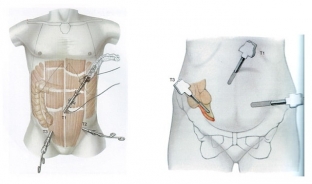Modern medicine does not stand still and is actively looking for new and, of course, better methods for diagnosing and treating common diseases. A classic surgical operation, with which young surgeons often begin their practice, is an appendectomy. New technologies dictate trends even in medicine, and today laparoscopic operations, including laparoscopic appendectomy, are increasingly being used in surgical practice. For the first time this method of treatment of acute appendicitis was used in 1983, and already in 1990 German scientists published the results of an extensive study in which they demonstrated good results and undeniable advantages of the surgical treatment of appendicitis with the laparoscopic method.
Indications and contraindications for laparoscopic appendectomy
Disputes about the indications and contraindications of laparoscopic appendectomy are still ongoing among surgeons of different generations. Often, opponents of laparoscopic appendectomy are surgeons of the "old school" who are accustomed to operating on appendicitis in the traditional way. However, there are clear indications and contraindications for laparoscopic appendectomy:
- Indications for laparoscopic appendectomy are almost the same as indications for traditional appendectomy: catarrhal, phlegmonous, gangrenous and gangrenous-perforated appendicitis;
- The main contraindication to laparoscopic appendectomy is a dense appendicular infiltrate or suspected periappendicular abscess;
- pregnancy is considered as a relative contraindication to laparoscopic appendectomy, since the effect of pneumoperitoneum, which is a necessary condition for all laparoscopic operations, on the fetus has not been sufficiently studied to date;
- Other contraindications for laparoscopic appendectomy are liver disease with portal hypertension and coagulation disorders.
Key steps for performing a laparoscopic appendectomy
The technique for performing laparoscopic appendectomy is described in the literature very clearly and is quite simple. Provided that the operating surgeon follows the recommendations for performing laparoscopic appendectomy, the result of the operation will be as positive as possible for the patient. The main steps of laparoscopic appendectomy are as follows:
- A pneumoperitoneum is applied using a Veress needle, which is inserted into the abdominal cavity through a puncture below the umbilicus.
- Three trocars for the laparoscope are inserted into the abdominal cavity: 10-11 mm. below the navel, 12 mm. in the middle of the distance between the navel and the pubic bone along the midline of the abdomen and 5 mm. over the projection of the appendix. If necessary, an additional fourth trocar 5 mm is introduced.
- Examination of the abdominal cavity is carried out, the appendix is located.
- The apex of the appendix is pulled up to the cannula to better visualize its mesentery.
- The mesentery of the appendix is transected using various methods: electrocautery, linear laparoscopic stapler, or staples.
- The appendix is crossed at the base with three endoligatures, after which it is crossed between them.
- The appendix is removed from the abdomen.
- The right iliac region is washed and drained, drainage is installed and wounds are sutured.
Post-op shows the benefits of laparoscopic appendectomy
Postoperative management of patients undergoing laparoscopic appendectomy is the same as for patients with traditional appendectomy: intravenous fluids, wound monitoring, antibiotic therapy as indicated. However, it is in the postoperative period that the & nbsp; main advantages of laparoscopic appendectomy. Such patients experience much less pain in the postoperative period, often they do not require the introduction of narcotic analgesics. The function of the intestine in such patients is restored much faster than after a traditional appendectomy: patients begin to eat on their own the very next day after the operation. The incidence of postoperative infection, as well as adhesive process in the abdominal cavity is much less after laparoscopic appendectomy. Patients can return to their usual way of life within a week after the operation. Thus, laparoscopic appendectomy is a fairly simple and very effective method of treating acute appendicitis.








Add a comment